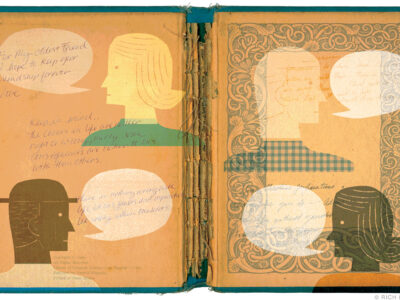
“Thanks to Greil Marcus, you can crank up the volume on your Sex Pistols album and call it research.”
So said Institute of Contemporary Art (ICA) curator Ingrid Schaffner in her introduction of the writer and cultural critic, whose lecture on March 18 was the keynote for the first annual Spiegel Symposium.
Actually, Marcus is more what you might call a counter-culture critic. Since becoming Rolling Stone magazine’s first record-review editor in the late 1960s, Marcus has been not only a legendary rock writer but also a dynamic public figure, a flamboyant but thoughtful critic of literature, film, and politics.
The Spiegel Symposium, endowed by the Emily and Jerry Spiegel Fund to Support Contemporary Culture and Visual Arts, was established this year to produce interdisciplinary programs in conjunction with an exhibition at the ICA. Jointly organized by the ICA and the departments of architecture, cinema studies, fine arts, and history of art, the theme was “Resistance,” a topic Marcus has tackled many times over the years in his magazine columns and nearly a dozen books. The two-day gathering also featured a tour and lecture by the artist of Barry Le Va’s exhibit, Accumulated Vision, at the ICA, as well as several film screenings and panel discussions. Schaffner herself took part in a panel called “The Trouble with Resistance,” which dealt with the challenges curators encounter in presenting work “that goes up hard against the contexts posed by exhibitions.” Le Va’s installations—room-scale displays of broken glass and felt—certainly fit the bill.
Marcus was an equally apt choice. Born in 1945, he still probes the culture with the same rebel spirit as 35 years ago when he opened what is probably the most famous record review of all time—his critique of Bob Dylan’s much-anticipated but, to many listeners, underwhelming 1970 album, Self-Portrait—by asking, “What is this shit?” Taking in everything from Kathleen Hannah (see below) to Hannah Arendt, his work is characterized by making surprising connections between seemingly unrelated blips in the culture, both highbrow and pop.
“It’s too bad you can’t judge a book by its cover,” Schaffner continued in her introduction. “But I like to think you can judge a book by its index.” She picked up Marcus’s best-known book, 1989’s Lipstick Traces: A Secret History of the 20th Century, and rattled off a few its index entries: Eisenhower, germ-free adolescence, bayou tapestry, the Kinks. The book, ostensibly a discussion of the punk movement, is actually a tour of American culture. Marcus’ talk, which he delivered to the audience in Meyerson Hall while struggling valiantly against a bad case of laryngitis, was similarly wide-ranging, packed with as many references as a T.S. Eliot poem—or maybe an episode of The Simpsons.
In thinking about the theme of resistance in art, Marcus said, a lot of things came to mind. He settled on a few: Philip Roth’s recent novels I Married a Communist and The Plot Against America; the 1935 novel It Can’t Happen Here by Sinclair Lewis; and the riot grrrl movement, an early-1990s underground feminist revolution rooted in primitive punk rock.
In Lewis’ book, a cowboy senator promises to suspend the U.S. Constitution in order to get the kind of “strong leader,” or dictator, that he says America needs. In I Married a Communist, the protagonist’s wife publishes a tell-all autobiography that reveals him as a communist and destroys his life.
“Is that what a book, or a song, should do?” Marcus asked. “Change things?”
He didn’t answer the question directly. But he got excited when he hit on the heart of the matter: “Lewis and Roth both suggest that our society is not stable—that anything can happen.”
From there, Marcus moved seamlessly into a discussion of Twin Peaks, David Lynch’s eerie TV series that debuted in 1990 and soon became a cult hit. At the center of that show—in a sense, its main character—was Laura Palmer, a young woman who was raped and murdered (by her father, it was eventually revealed) before the action of the show begins. At the same time that the fictional town of Twin Peaks was looking for a murderer, said Marcus, the town of Olympia, Washington, was identifying another villain, this one very real.
The first rumblings of the revolution came in the form of strange graffiti. “This graffiti is best described as ‘anti-male,’” Marcus read, quoting from an amusingly out-of-the-loop news story from the town’s newspaper, the Daily Olympian. “‘Dead men don’t rape.’ ‘God is gay.’
“Some of the graffiti doesn’t even make sense,” the article continued, citing one spray-painted message that read “Bikini Kill.”
In fact, Marcus noted, Bikini Kill was a rage-fueled, all-girl, barebones punk outfit fronted by the demonic-voiced, college-aged singer Kathleen Hannah that inspired other young women to pick up guitars and sing—or howl—about taboo topics like incest, homosexuality, and sexism at rock shows.
“Fuck Twin Peaks!” Marcus read (twice) with obvious delight, quoting a ’zine called Riot Grrrl, the self-published feminist magazine that became the name of the burgeoning movement.
“Kathleen Hannah screamed the scream that Laura Palmer never got to scream,” Marcus summed up, in a beautiful moment of pop-fiction meets pop-reality.
“Fifteen years later,” he said of the ’zine, “the joy still leaps off the pages.” That joy is what Thomas Jefferson called public happiness, the ability to form a community, learn the subtlety of the language of oppression, and create a language of revolution, he added. Just like Roth and Lewis, those young women spoke their minds—“made their own public squares.”
But was their town any different after they moved on? It’s impossible to know, in political or artistic terms, just what lasting impact individual movements of resistance have on the larger culture, Marcus said. But he did offer this: to live in a culture of resistance—“a culture of no”—is to gain a sense of one’s own weakness, to remain forever unsatisfied with the world and with yourself. The significant thing was that, like the characters in Roth’s and Lewis’ novels, the women themselves were changed by their actions.
Forty years from now, readers might look back on Roth’s The Plot Against America, which posits the election of an isolationist and Nazi-sympathizing Charles A. Lindbergh as president in 1940, as an act of political defiance, Marcus suggested. “But for now it repels any attempt to identify it as resistance. Today it is ordinary free speech, not special, just an author with a new book.
“And that’s as it should be.”
—Katie Haegele C’98




